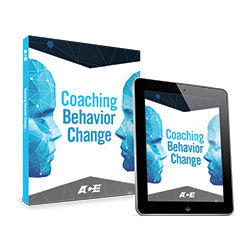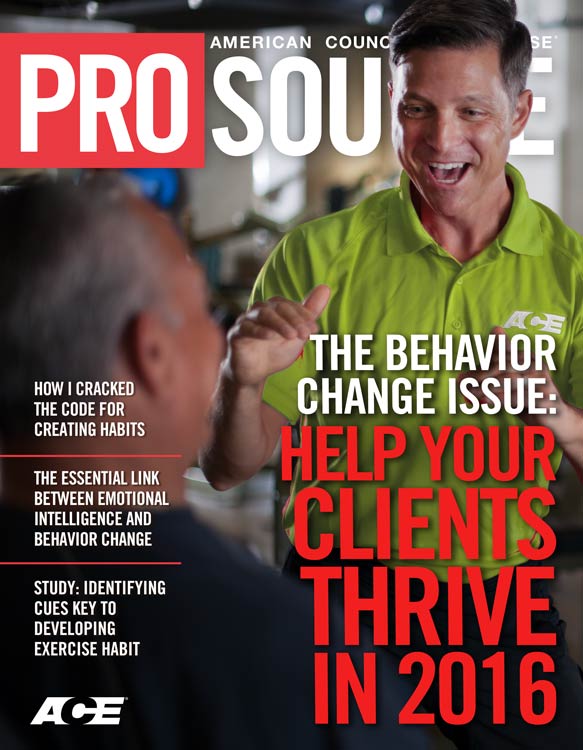
The following article is excerpted from the new book, Coaching Behavior Change, which is a key component of ACE’s new Behavior Change Specialty Certification. Inspiring people to adopt new behaviors requires more than knowledge of behavior philosophy or emotional intelligence. With contributions from renowned experts and pioneers in the areas of psychology and coaching, the Behavior Change Specialty was created to give fitness and allied health professionals the practical, hands-on skills needed to guide people toward behavior change in one-on-one, group and virtual settings.
I began playing around with new ways to change my behavior in early 2011. And that led to a breakthrough now called Tiny Habits.
It all started one day when I had this insight:
“Hey, BJ, you already know how to floss all your teeth. What you haven’t mastered is how to floss every day, automatically.”
So I set out to find a solution.

DEVELOP SKILLS TO GUIDE SUSTAINABLE CHANGE
No matter how you work with clients and patients, effective coaching can further heighten the impact of your program. As an ACE Behavior Change Specialist you will possess the knowledge of behavior change philosophy and emotional intelligence and, most importantly, the practical, hands-on skills to put it to use. Our comprehensive, learning experience incorporates expertise from renowned experts and pioneers in psychology and coaching to help you learn how to develop rich, productive relationships and guide people toward sustainable change in one-on-one, group and virtual settings.
Learn more>>
SIMPLICITY MATTERS MORE THAN MOTIVATION
My background in studying human behavior made it clear that simplicity mattered; I knew that simplicity could mean the difference between doing a behavior and not doing it.
So I scaled flossing back to the simplest form: floss just one tooth. At the time, this sounded ridiculous to me, but I reminded myself: I didn’t need to learn to floss all my teeth. Instead, I needed to focus on making flossing automatic.
As I was looking for my solution, I’d already developed the Fogg Behavior Model. That framework clearly shows that if a behavior is really easy, you don’t need much motivation to do it. However, if the behavior is hard, you need a lot of motivation.
My research showed that motivation could be unreliable, going up and down moment by moment. I was wary about relying on motivation. It was natural for me to make simplicity a big part of my solution. The simpler, the better. I knew that.
EMOTIONS CREATE HABITS
The next insight—the role of emotions—was something of an accident.
Somehow I knew that if I felt good about flossing one tooth, I’d keep doing it. So each day as I flossed, I thought this to myself: “If everything ends up awful today, at least I did one thing right: I flossed one tooth. Good for me—Victory!”
I look back now and see that I got lucky. At the time I didn’t fully realize that emotions create habits. In other words, if you feel a positive emotion while you’re doing a new behavior or immediately after, the new behavior will become more automatic. Your brain will want to do it again. Here’s how it works: The speed of habit formation is directly related to the immediacy and intensity of emotions you feel.
Back then, I used “Victory!” a lot. That was my goofy celebration. Today I have many ways to celebrate my Tiny Habits (dancing anyone?). But even my rudimentary “Victory!” worked well, because it made me feel good, like I was succeeding. As a result, I kept flossing. Soon flossing became a solid habit.
After a few weeks, I was flossing all my teeth daily, not just one. The habit didn’t feel like a chore. Instead, I would look forward to the next opportunity. (I’d floss morning and night; I still do.) And when I couldn’t floss, I felt like I was missing out.
HACKING MORE OF MY BEHAVIORS
I then started applying this behavior hack—make it simple and celebrate it—to other behaviors I wanted: drink more water, eat veggie snacks during the day and so on. I knew that making the behavior tiny was a good thing. If it was small, I had no excuse not to do it. And I didn’t need much motivation.
And I also knew that saying “Victory!” after doing the behavior worked. It made me want to do the behavior again.
I look back now and see I’d solved two important pieces of the puzzle:
Make the new behavior you want really small.
Celebrate doing the behavior immediately.
These two things mattered, of course, but I hadn’t figured out the entire solution.
PUT NEW BEHAVIOR “AFTER” AN EXISTING ROUTINE
I knew there was still a piece missing: How do I remind myself to do the tiny behavior?
I didn’t try using reminder notes, because I knew that approach wouldn’t scale. And besides, it was ugly. If I used notes, then I would probably end up with dozens, if not hundreds, of little notes plastered around my house and office. Did I want that? No.
The answer wasn’t obvious to me, until one day . . .
I was getting out of the shower and drying off. I went into my bedroom to dress. I was doing a typical sequence of behaviors—my routines. And then it happened. I opened my sock drawer and this word struck me: after.
I recognized this as my answer. The final piece of the habit puzzle had five letters: A-F-T-E-R.
After!
I said to myself: “You won’t be able to form habits quickly until you know what the new behavior comes after.”
I got chills. It was a big moment.
You figure out where the new tiny behavior fits into your life.
Today this is a key part of the Tiny Habits method. You figure out where the new tiny behavior fits into your life—what routine does it come after? In other words, you use an existing routine (brushing) to remind you to do the new tiny behavior (floss one tooth).
I call the existing routine an “anchor.” In the Tiny Habits method, you pair the new tiny behavior with an anchor. If you pair it well, the tiny behavior flows easily after the anchor. Sometimes it feels like magic.
|
ANATOMY OF TINY HABITS
|
|
1. Anchor Moment
An existing routine (like brushing your teeth) or an event that happens (like a phone ringing). The Anchor Moment reminds you to do the new Tiny Behavior
|
|
2. New Tiny Behavior
A super simple version of the new behavior you want, such as flossing one tooth or doing two push-ups. You do the Tiny Behavior immediately after the Anchor Moment.
|
|
3. Instant Celebration
Something you do to create positive emotions, such as saying “Nicely done!” You celebrate immediately after doing the New Tiny Behavior.
|
THE RECIPE FOR TINY HABITS
I call this a Tiny Habit “recipe,” and you write it up like this:
“After I __________, I will ___________.”
Below are some examples of Tiny Habit recipes:
After I brush my teeth, I will floss one tooth.
After I start the coffee, I will open my “to do” list.
After I empty my spam folder, I will meditate for three breaths.
After I empty my water glass, I will refill it.
After I pee, I will do two push-ups.
After I walk in the door, I will hang my keys on the hook.
After I turn off the TV at night, I will set out my gym clothes.
REMARKABLE RESULTS
Once I figured out all the pieces to the puzzle, I started using my method to change lots of things in my life. One month I mapped out 16 Tiny Habit recipes. I practiced these habits, and I was successful at 15 of them. (What didn’t work? Meditating for three breaths. I couldn’t figure out where this fit naturally in my day.)
I thought 15 out of 16 was a striking result. So I posted it to Twitter. Right away, I saw that some people didn’t believe me. They thought it was impossible. They tweeted back these misguided assumptions: “You can only create one habit at a time” and “It takes 21 days to create a habit.”
I was happy to prove those old assumptions wrong—at least for me.
Change behavior without relying on willpower.
I kept going with my Tiny Habits method, creating many new habits in my life. Over time, I dropped 10 percent of my body weight, and my blood pressure went down. All the while I felt more confident about everything I was doing. Why? I knew I could change my behavior quickly and easily.
With the Tiny Habits method, I cracked the code for adding new habits to my life. I was sure about that. I saw evidence that I could change my behavior without relying on willpower. I was pretty sure if I could teach other people the method, they would also be able to change quickly and easily.
SHARING TINY HABITS WITH OTHERS
I decided to teach a few friends my Tiny Habits method. I posted a question to Facebook to see if people were interested. A few people said “yes.” So I wrote up the instructions and shared it with them in December 2011, nicely timed before the New Year.
That first week about 60 people joined me. It worked well for many of them. A few people didn’t understand my instructions. So I revised and tried again. The next week about 150 joined in. People then told their friends, and it just kept growing.
The original Tiny Habits program runs for 5 days, Monday through Friday. It takes about 45 minutes from start to finish—about 20 minutes to get started and then about 5 minutes a day. Usually, I interact with people through email.
As the months went by, I coached a few hundred new people each week in the Tiny Habits method. At the time I knew my method worked, but I didn’t fully understand why. Today I have more insight into the secret sauce of Tiny Habits.
WHY THE TINY HABITS METHOD WORKS
For a long time I’ve asked myself this question: Why hasn’t anyone discovered this method before? As a Stanford-trained experimental psychologist, I have studied human behavior for almost 20 years. And I have never found anyone or any method that pulled all the right pieces together.
The Tiny Habits method seems obvious to me now. I suppose it’s something like a riddle. When you don’t know the answer, it seems like a hard problem, maybe impossible to solve. But once you see the answer, it seems obvious: “Aha! Of course that’s the answer.”
I don’t have space here to explain all the ingredients in the secret sauce, but below are some of the vital elements:
- Pick new behaviors you want (not things you “should” do).
- Make it really easy to do the behaviors.
- Make sure there’s something that prompts you to do the behavior.
- Find a way to feel good immediately after doing the behavior.
If you do any one of these things, you are on the right path to creating habits. If you do all of them together—the Tiny Habits method—you will be on the express train to a better life.
Note what’s not on my list above: willpower or motivation. I’ve learned that creating new habits is not a matter of willpower. It’s a matter of design. To be clear, motivation is not the key to habit formation. Yes, you have to pick new behaviors you want (the method doesn’t magically give you habits you don’t want). But motivation isn’t the critical factor if you make the behavior easy enough.
SUCCESS MAKES TINY HABITS GROW
Some people ask this question: Well, what’s the use of flossing just one tooth? Or doing just two push-ups? I need to floss all my teeth. I want to do 20 push-ups so I can get strong.
I explain: What you’re doing at the early stage is building automaticity. If you make the new behavior painful or hard in any way, your brain will find ways to stop you from doing it. You will conveniently “forget,” or you’ll find some excuse. So you need to start very small.
Tiny habits grow naturally to their expected size.
On days when you really want to do more push-ups, then do more. That’s fine. But it’s never a requirement. When you go beyond the tiny behavior, you should view it as “extra credit”—and you need to feel extra good about it. That way you can continue to strengthen the habit.
The more you do a behavior, the easier it gets. For example, when I got really good at flossing one tooth, then flossing all my teeth was also easier than ever before. You need to trust in this face: Success leads to success.
The more you do a behavior, the easier it gets.
In the tiny habits method, you allow the tiny behavior to grow naturally. You don’t force it. It’s a lot like growing a small plant: You can’t force it to grow. Just keep nurturing it and making sure the environment is conducive to growth.
I believe this metaphor is perfect for how habits form:
“If you plant the right seed in the right spot, it will grow without coaxing.”
The “right seed” is the tiny behavior that you want. The “right spot” is the sequencing—what it comes after. The “coaxing” part is amping up motivation, which I think has nothing to do with creating habits. In fact, focusing on motivation as the means to habits is exactly wrong.
Let me be more explicit: If you pick the right small behavior and sequence it right, then you won’t need to motivate yourself to have it grow. It will just happen naturally, like a good seed planted in a good spot. (Unfortunately, this is also the process for bad habits—they start tiny, and they wedge themselves in a fertile spot.)
With time, Tiny Habits will grow to their natural size. You will go from flossing one tooth to flossing all your teeth. You’ll expand from two push-ups to 15. You’ll grow tiny exercise behaviors into longer sessions.
THREE TYPES OF TINY HABITS: BLADE, SHRUB, TREE
1. I classify Tiny Habits into three types. I call one “blade,” like a blade of grass. It starts tiny. It won’t grow big. And that’s okay. It’s pretty easy to create a lot of “blade” behaviors (metaphorically, think of it as a big lawn or meadow). Many blade-size behaviors can have a big impact on your life.
2. The next category, I call “shrub.” The habit starts small and it grows a little bit. But it never gets huge. And that’s okay. Flossing one tooth grows to flossing all your teeth. Pouring a glass of water becomes drinking water throughout the day. You start tiny and you allow the behavior to naturally grow.
3. The final category is what I call “tree.” It starts small, and you hope it grows very large. Tree habits are things like exercising for an hour a day and radically changing your diet. These habits take a lot of time and nurturing. You have to be patient. If you artificially amp up the new behavior to a size or intensity that is painful, you are weakening the habit. You are going backward.
I’m a fan of blades and shrubs. It’s so easy to form these habits. When you create many habits that are the size of blades and shrubs, your life will change in a big way. And when one habit breaks, they don’t all break. In other words, changing many small behaviors seems to be more robust— a better investment—than trying to create one big change.
TINY HABITS AND UNWANTED BEHAVIORS
You may be wondering how to use the Tiny Habits method to get rid of unwanted behaviors. My answer is this: I don’t know for sure. To be clear, Tiny Habits is a method for bringing new behaviors into your life, not for getting rid of unwanted behaviors.
People have told me they’ve used my method to stop bad habits. So yes, I think it’s possible. However, I haven’t studied how this works. And I don’t want to speculate. As it stands, I can vouch for all the insights in this article. I don’t want to put guesses next to what I know are facts.
HELP PEOPLE FEEL SUCCESSFUL
After personally coaching more than 25,000 people in Tiny Habits, I have a strong point of view about how to help people improve their lives. As coaches, we need to set people up for success, not for failure. When you put people on a program and they fail, you damage them. You make them less likely to succeed in the future.
We need to set people up for success, not failure.
So above all else, no matter what approach you take, help people feel like they are succeeding. I deeply believe that’s the key to achieving long-term change in challenging areas like nutrition, stress and physical activity.
I’ve seen this clearly: When people feel successful, they keep going. They start to change other behaviors in their life, both big and small. It’s a natural process. But it only happens if people feel successful.
I believe the easiest, fastest way to show people they can change their lives is through the Tiny Habits method. In just five days, most people see evidence they are learning to change. They prove it each morning as they see themselves in the mirror, flossing one tooth. They see someone who is learning to change.
And with this new mindset—yes, I can improve my life—people are ready to take on bigger challenges.
© 2014 BJ Fogg. Printed with permission from BJ Fogg, Ph.D. Not for reproduction.
Resources for Learning More





 by
by 



